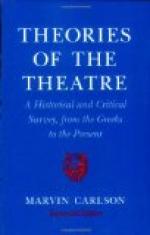It may be profitable to notice some of the technical devices by which attention is economised in the theatre and the interest of the audience is thereby centred upon the main business of the moment. In particular it is important to observe how a scattering of attention is avoided; how, when many things are shown at once upon the stage, it is possible to make an audience look at one and not observe the others. We shall consider the subject from the point of view of the dramatist, from that of the actor, and from that of the stage-manager.
II
The dramatist, in writing, labors under a disadvantage that is not suffered by the novelist. If a passage in a novel is not perfectly clear at the first glance, the reader may always turn back the pages and read the scene again; but on the stage a line once spoken can never be recalled. When, therefore, an important point is to be set forth, the dramatist cannot afford to risk his clearness upon a single line. This is particularly true in the beginning of a play. When the curtain rises, there is always a fluttering of programs and a buzz of unfinished conversation. Many spectators come in late and hide the stage from those behind them while they are taking off their wraps. Consequently, most dramatists, in the preliminary exposition that must always start a play, contrive to state every important fact at least three times: first, for the attentive; second, for the intelligent; and third, for the large mass that may have missed the first two statements. Of course, the method of presentment must be very deftly varied, in order that the artifice may not appear; but this simple rule of three is almost always practised. It was used with rare effect by Eugene Scribe, who, although he was too clever to be great, contributed more than any other writer of the nineteenth century to the science of making a modern play.
In order that the attention of the audience may not be unduly distracted by any striking effect, the dramatist must always prepare for such an effect in advance, and give the spectators an idea of what they may expect. The extraordinary nose of Cyrano de Bergerac is described at length by Ragueneau before the hero comes upon the stage. If the ugly-visaged poet should enter without this preliminary explanation, the whole effect would be lost. The spectators would nudge each other and whisper half aloud, “Look at his nose! What is the matter with his face?”, and would be less than half attentive to the lines. Before Lady Macbeth is shown walking in her sleep and wringing her hands that are sullied with the damned spot that all great Neptune’s ocean could not wash away, her doctor and her waiting gentlewoman are sent to tell the audience of her “slumbery agitation.” Thus, at the proper moment, the attention is focused on the essential point instead of being allowed to lose itself in wonder.




